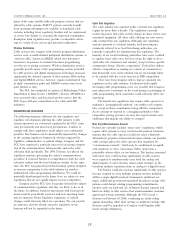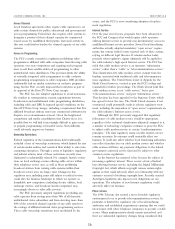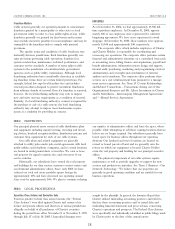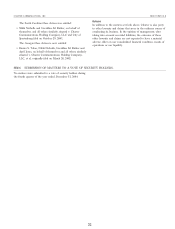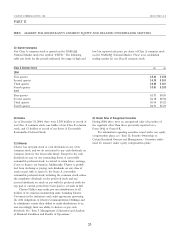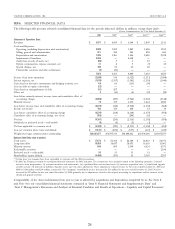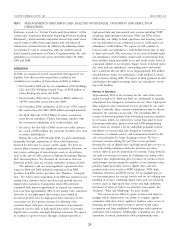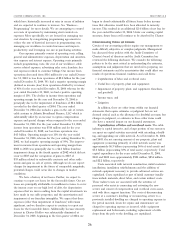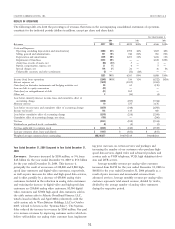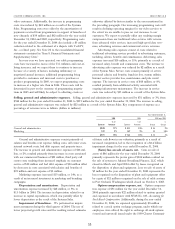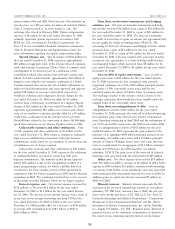Charter 2004 Annual Report Download - page 35
Download and view the complete annual report
Please find page 35 of the 2004 Charter annual report below. You can navigate through the pages in the report by either clicking on the pages listed below, or by using the keyword search tool below to find specific information within the annual report.
CHARTER COMMUNICATIONS, INC. 2004 FORM 10-K
ITEM 7. MANAGEMENT’S DISCUSSION AND ANALYSIS OF FINANCIAL CONDITION AND RESULTS OF
OPERATIONS.
Reference is made to ‘‘Certain Trends and Uncertainties’’ of this high-speed data and incremental new services including VOIP
section and ‘‘Cautionary Statement Regarding Forward-Looking telephony, high definition television, VOD and DVR service.
Statements,’’ which describes important factors that could cause Historically, our ability to fund operations and investing activi-
actual results to differ from expectations and non-historical ties has depended on our continued access to credit under our
information contained herein. In addition, the following discus- subsidiaries’ credit facilities. We expect we will continue to
sion should be read in conjunction with the audited consoli- borrow under our subsidiaries’ credit facilities from time to time
dated financial statements of Charter Communications, Inc. and to fund cash needs. The occurrence of an event of default under
subsidiaries as of and for the years ended December 31, 2004, our subsidiaries’ credit facilities could result in borrowings from
2003 and 2002. these facilities being unavailable to us and could, in the event of
a payment default or acceleration, trigger events of default under
our notes and our subsidiaries’ outstanding notes and would
INTRODUCTION have a material adverse effect on us. Approximately $30 million
In 2004, we completed several transactions that improved our of indebtedness under our subsidiaries’ credit facilities is sched-
liquidity. Our efforts in this regard have resulted in the uled to mature during 2005. We expect to fund payment of such
completion of a number of transactions in 2004, as follows: indebtedness through borrowings under our subsidiaries’ revolv-
ing credit facilities.
(the December 2004 sale by our subsidiaries, CCO Holdings,
LLC and CCO Holdings Capital Corp., of $550 million of Overview of Operations
senior floating rate notes due 2010; Approximately 86% of our revenues for the each of the years
(the November 2004 sale by Charter of $862.5 million of ended December 31, 2004 and 2003 are attributable to monthly
5.875% convertible senior notes due 2009; subscription fees charged to customers for our video, high-speed
data, telephone and commercial services provided by our cable
(the December 2004 redemption of all of our 5.75% convert- systems. Generally, these customer subscriptions may be discon-
ible senior notes due 2005 ($588 million principal amount); tinued by the customer at any time. The remaining 14% of
(the April 2004 sale of $1.5 billion of senior second-lien revenue is derived primarily from advertising revenues, franchise
notes by our subsidiary, Charter Operating, together with fee revenues, which are collected by us but then paid to local
the concurrent refinancing of its credit facilities; and franchising authorities, pay-per-view and VOD programming
where users are charged a fee for individual programs viewed,
(the sale in the first half of 2004 of non-core cable systems
installation or reconnection fees charged to customers to
for a total of $733 million, the proceeds of which were used
commence or reinstate service, and commissions related to the
to reduce indebtedness.
sale of merchandise by home shopping services. We have
During the years 1999 through 2001, we grew significantly,
increased revenues during the past three years, primarily
principally through acquisitions of other cable businesses
through the sale of digital video and high-speed data services to
financed by debt and, to a lesser extent, equity. We have no
new and existing customers and price increases on video
current plans to pursue any significant acquisitions. However, we
services offset in part by dispositions of systems. Going forward,
may pursue exchanges of non-strategic assets or divestitures,
our goal is to increase revenues by stabilizing our analog video
such as the sale of cable systems to Atlantic Broadband Finance,
customer base, implementing price increases on certain services
LLC discussed above. We therefore do not believe that our
and packages and increasing the number of our customers who
historical growth rates are accurate indicators of future growth.
purchase high-speed data services, digital video and new
The industry’s and our most significant operational chal-
products and services such as VOIP telephony, VOD, high
lenges in 2004 and 2003 included competition from DBS
definition television and DVR service. To accomplish this, we
providers and DSL service providers. See ‘‘Business — Competi-
are increasing prices for certain services and we are offering new
tion.’’ We believe that competition from DBS has resulted in net
bundling of services combining digital video and our advanced
analog video customer losses and decreased growth rates for
services (such as high-speed data service and high definition
digital video customers. Competition from DSL providers
television) at what we believe are attractive price points. See
combined with limited opportunities to expand our customer
‘‘Business — Sales and Marketing’’ for more details.
base now that approximately 28% of our analog video customers
Our success in our efforts to grow revenues and improve
subscribe to our high-speed data services has resulted in
margins will be impacted by our ability to compete against
decreased growth rates for high-speed data customers. In the
companies with often fewer regulatory burdens, easier access to
recent past, we have grown revenues by offsetting video
financing, greater personnel resources, greater brand name
customer losses with price increases and sales of incremental
recognition and long-established relationships with regulatory
advanced services such as high-speed data, video on demand,
authorities and customers. Additionally, controlling our cost of
digital video recorders and high definition television. We expect
operations is critical, particularly cable programming costs,
to continue to grow revenues through continued growth in
25


